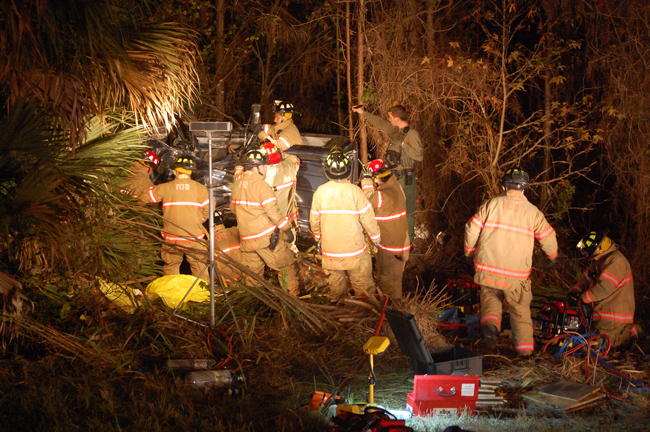
It is an exhaustive, and grim, report: the annual tabulation of deaths, injuries and other hazards of Flagler and Florida roads by the state’s motor vehicle department, released Wednesday, on a day that saw the third road fatality in Flagler in three days.
In Flagler, there were 716 crashes in 2010–just one more than the previous year–or about two crashes a day, 11 percent of them involving alcohol. There were a total of 23 fatalities on Flagler roads last year, up from 16 in 2009 and 2007, but down from the 30 recorded in 2006 and the 31 recorded in 2008.
Ten of the fatalities last year, or close to half, involved alcohol.
Click On:
- SR100 Hit-and-Run Fatality: Investigators Focusing on Three Flagler School Buses
- Ride In Peace: Kirt Smith (1995-2011) Would Have Been 16 on Thursday
- Light Up Palm Coast: Petitioning the City Council to Put Safety Before Beautification
- Native Sons: Remembering Josh Crews One Young Writer at a Time, With a Ball
In Florida, 2,444 people were killed on roads in 2010, including 499 pedestrians, 76 bicyclists, 383 motorcyclists and 144 teen-agers. There were a total of 235,461 crashes, or 645 crashes per day.
The numbers are slightly down from the previous year, when there were 235,778 crashes and 2,563 fatalities.
Of those, 794 fatalities involved alcohol, down from 1,004 the year before. But the state cautions in a footnote that “the significant drop in alcohol-related fatalities is due to under-reporting of blood alcohol content by law enforcement agencies.” The state had averaged slightly more than 1,000 fatalities with alcohol involved in the previous four years.
In Flagler County, the worst crash took place on I-95 three weeks before Christmas, on Dec. 6, when five adults were killed in a van that smashed into the woods. There were nine people in the van, including four children, who all survived.
As was the case this very week, three people were killed on three successive days in June 2010 in three separate crashes.
The numbers shed some light on the relationship between crashes and safety equipment.
Of the total number of fatalities, 1,450 took place in vehicles equipped with safety belts. Some 54 percent of those fatalities, or 777, involved people not wearing their safety belt.
Among motorcyclists, the 383 fatalities break down this way: 196 (or 51 percent) were wearing a helmet, 141 (or 36 percent) were not, and 46 fatalities’ reports did not state whether a helmet was or wasn’t used. Helmeted motorcyclists also suffered incapacitating injuries at about the same rate, as opposed to un-helmeted motorcyclists.
The difference is far more stark when it comes to bicyclists: there were 76 fatalities in all. Of those, 68 were not wearing a helmet, or 89 percent. On the other hand, the number of cyclists killed in 2010 is the lowest in at least 10 years, and is down from a peak of 124 in 2006. Many numbers peaked in 2006: that was the year of Florida’s housing boom peak, too.
The greatest chance of being in a vehicle crash involves drivers between the ages of 15 and 24. The single-most dangerous age is 18: the crash rate per 10,000 licensed drivers is 3.56 for 18 year olds. In comparison, 75 year olds have a crash rate of less than 1 per 10,000 drivers, and those 90 years old or older have a crash rate of 1.70.
While teens often get considerable attention in driving fatalities or injuries, the fact remains that teen deaths and injuries involve a relatively small proportion of the overall toll on life and limb on Florida’s roads: 72 percent of all fatalities involve drivers between the ages of 21 and 64. That’s also because the majority of drivers are between those ages.
Nevertheless, 140 children lost their lives on Florida roads last year, including 49 younger than 10.
The number of licensed drivers in Florida leveled off since 2004, and has, in fact, been dropping. It peaked at 15.6 million in 2007. It has fallen each of the last two years, and was down to 15.5 million in 2010. The number of registered vehicles has also fallen from a peak of 15.97 million in 2008 to 14.84 million last year. The drop could be attributed to a variety of factors, including the state’s high unemployment rate, which reduces the number of people who need cars to go to work, or the state’s slight population drop. The number of vehicle miles driven has also been dropping considerably, from a high of 205 billion to 196 billion last year.
The rate falls progressively after that, reaching its low for drivers 65 to 69 years old, then the rate starts rising again, but even drivers 90 years old or older have a crash rate lower than that of drivers 49 or younger.
A few more numbers:
The March, April and May are the most dangerous months on Florida roads, judging from the number of crashes. July is the safest month.
Careless driving is the leading cause of crashes, with 18.6 percent of all fatal crashes related to careless driving, and 40 percent of crashes with injuries. Alcohol is the second-leading cause, with 14.85 percent of fatal crashes involving alcohol. Speeding was involved in almost 12 percent of fatal crashes. “Driver distraction” involved less than 1 percent of fatal crashes. (Those figures are from one of two reporting standards. A newer reporting standard lists causes of crashes differently, and has somewhat different results.)
![]()





























Leave a Reply